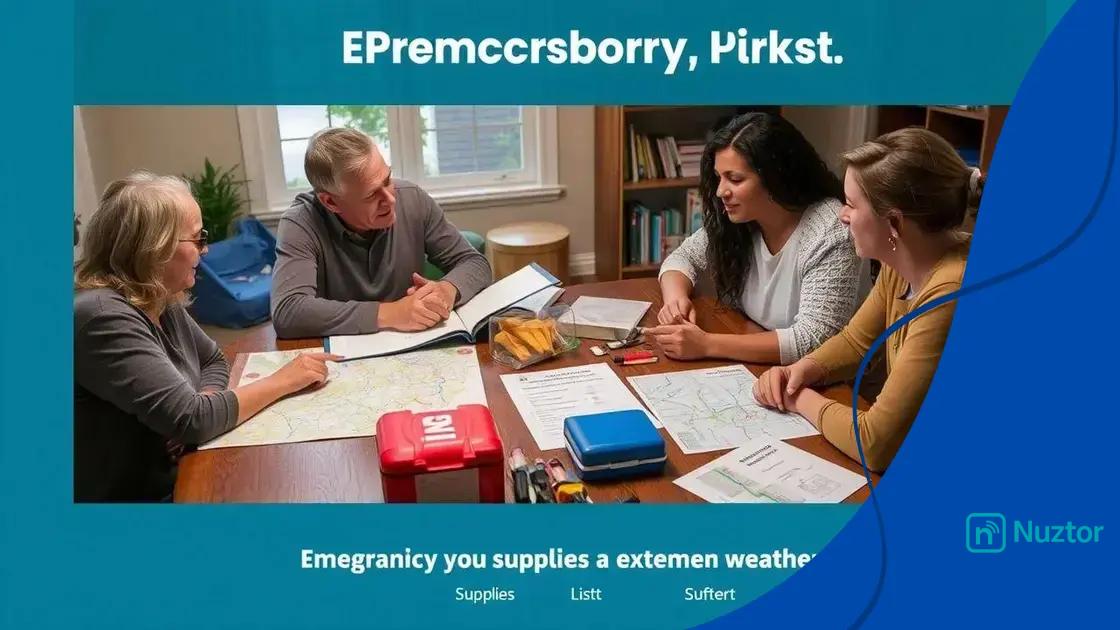Extreme weather preparedness: Are you ready for the worst?

Extreme weather preparedness involves understanding potential disasters, creating an emergency plan, gathering essential supplies, and leveraging community resources to ensure safety during crises.
Extreme weather preparedness matters more than ever in today’s changing climate. Are you equipped to handle storms, floods, and other disasters? Let’s dive into what you need to know to stay safe.
Understanding extreme weather events
Understanding extreme weather events is crucial for effective preparedness. These events can range from intense storms to extreme heat, and knowing what to expect can help safeguard lives.
Types of Extreme Weather
Different types of extreme weather can impact various regions differently. Recognizing the key kinds of events is the first step in preparation.
- Hurricanes: Powerful storms that can cause devastating floods and strong winds.
- Heatwaves: Prolonged periods of excessive heat that can be dangerous, especially for vulnerable populations.
- Floods: Can occur from heavy rains or melting snow, leading to property damage and health risks.
- Tornadoes: Rapidly rotating columns of air that can destroy buildings and uproot trees.
Each of these events presents unique challenges. For example, hurricanes require knowledge of evacuation routes and safe zones, while heatwaves necessitate hydration and indoor cooling. Understanding these factors can help you create a robust plan.
How Extreme Weather Affects Communities
Extreme weather does not affect everyone equally. Different communities may experience varying outcomes based on geography, infrastructure, and even socio-economic status. Poorly built homes are more susceptible to severe damage, making it vital for communities to invest in stronger structures.
Furthermore, during an event, access to resources can be severely limited. Understanding your local environment and potential risks is key in crisis management. Planning ahead by identifying safe places and knowing your resources can greatly improve safety.
As climate change continues to exacerbate the frequency and intensity of these events, staying informed and adaptable is becoming increasingly important. Workshops, local alerts, and community meetings can help you stay updated and engaged.
Essential supplies for extreme weather
Having essential supplies for extreme weather can be a lifesaver. Being prepared with the right materials ensures you and your family can stay safe during crises.
Must-Have Supplies
When preparing for severe weather, consider gathering the following items:
- Water: Always store at least one gallon of water per person per day for at least three days.
- Non-perishable Food: Stock up on canned goods, granola bars, and dried fruits to last for several days.
- First-Aid Kit: Include bandages, antiseptic wipes, and any personal medications required.
- Flashlights and Batteries: These are essential for power outages. Don’t forget extra batteries!
Other supplies may help you stay comfortable and safe. For instance, blankets can keep you warm, and a battery-powered radio helps you stay informed about changing weather conditions.
Creating a Family Emergency Kit
Building a family emergency kit is a great way to ensure everyone knows what to do when an extreme weather event occurs. Gather all supplies in a sturdy backpack or plastic container. Make sure to include:
- Personal Items: Clothing, ID, and any other essential documents should be included.
- Mobile Phone Chargers: Keeping devices charged can help you stay connected.
- Local Maps: In case of evacuation, having a paper map can guide you if GPS fails.
It is important to regularly check and update your kit. Over time, food and medications can expire, so keep your supplies fresh. Involving the whole family in this task can help everyone feel empowered and aware.
Creating an emergency plan

Creating an emergency plan is vital for navigating extreme weather situations. Knowing what to do ahead of time can save lives and reduce panic during a crisis.
Steps to Develop Your Plan
Start by discussing the plan with your family. Ensure everyone understands the basics and their roles. Here are key elements to include:
- Communication: Decide how you will stay in touch during emergencies.
- Evacuation Routes: Identify safe locations and routes to follow in case of evacuation.
- Meeting Places: Set designated spots to gather if separated.
- Important Contacts: Compile a list of emergency numbers, including family members, local authorities, and friends.
Training everyone in your family on these details creates a sense of security. Practice your plan regularly to keep everyone sharp and informed. Simulating various scenarios helps identify potential gaps in your planning.
Special Considerations
Consider unique needs when creating your plan. For instance, if you have elderly relatives or young children, additional preparations may be necessary. Also, pets should not be forgotten. Include them in your plan to ensure their safety.
Reviewing your plan annually is essential. Circumstances change, and updating your plan keeps it relevant and practical. This will prepare you better for different kinds of extreme weather events.
Staying informed during crises
Staying informed during crises is vital to ensure safety and effective response. When extreme weather strikes, having access to real-time information can help you make informed decisions quickly.
Sources of Information
Reliable sources can provide updates about ongoing situations. Use the following resources to stay updated:
- Local News Outlets: Television and radio stations offer real-time updates and expert analyses.
- Weather Apps: Download reliable apps that send alerts for severe weather in your area.
- Social Media: Follow local authorities and meteorologists for instant updates.
- Emergency Alert Systems: Sign up for notifications from local emergency management agencies.
In situations where power may be lost, consider alternative methods for receiving information. A battery-operated radio can be a lifesaver, allowing you to listen to news broadcasts when the electricity goes out.
Communicating with Loved Ones
During a crisis, ensuring communication with family and friends is crucial. Establish protocols in advance. Agree on a way to check in with each other, even if digital channels fail. This could include:
- Text messaging: It often uses less bandwidth than phone calls.
- Designated meeting spots: Know where to go if you cannot communicate.
- Group messaging apps: Use platforms like WhatsApp or Telegram to stay connected in larger groups.
Plan how to share updates and stay engaged with your community. Participating in community forums can provide useful information and strengthen bonds that ensure mutual support.
Community resources for disaster relief
Community resources for disaster relief play an important role in providing support during extreme weather events. Knowing these resources can help families and individuals get the assistance they need quickly.
Local Organizations
Many local organizations are dedicated to helping those affected by disasters. Get to know these resources in your area:
- Red Cross: Provides shelter, food, and medical assistance.
- Community Centers: Often serve as shelters and information hubs during crises.
- Religious Organizations: Many offer support services, meals, and volunteering opportunities.
- Local Government Agencies: These agencies coordinate disaster response efforts and can direct you to available resources.
These groups often conduct outreach efforts before storms, offering education on how to prepare for disasters. Joining local meetings or volunteer events can help you learn more about available resources.
Emergency Shelters
During disasters, emergency shelters are critical for providing safe havens to those displaced. Knowing the locations of these shelters can save lives. They typically offer:
- Safe Spaces: Shelters provide protection from hazards like severe storms.
- Basic Needs: Food and water are often supplied to guests.
- Healthcare Services: Some shelters may have medical personnel present to assist.
Emergency management agencies usually publish lists of shelter locations ahead of time. Residents should familiarize themselves with these locations and how to get there quickly.
Engaging with your community’s disaster relief resources can foster connections that lead to better preparedness and support. During a crisis, having these relationships can make a significant difference in recovery.
In summary, being prepared for extreme weather through understanding resources, creating a solid emergency plan, and staying informed is essential for ensuring safety and well-being. By leveraging community support and having the right supplies, you increase your chances of staying safe during crises. Remember, preparation is key to resilience in the face of nature’s challenges.
FAQ – Questions about Extreme Weather Preparedness
What is the first step in preparing for extreme weather?
The first step is to understand the types of extreme weather events that could occur in your area and gather necessary information.
How can I create an effective emergency plan?
Involve your family in creating a detailed plan that includes communication methods, evacuation routes, and meeting places.
What essential supplies should I have on hand?
Be sure to stock up on water, non-perishable food, first-aid kits, flashlights, and important documents.
How can community resources help during a disaster?
Local organizations and emergency shelters provide critical assistance, including food, shelter, and medical care during and after extreme weather events.